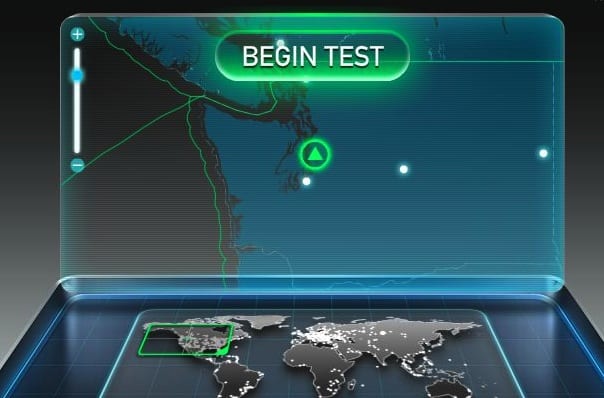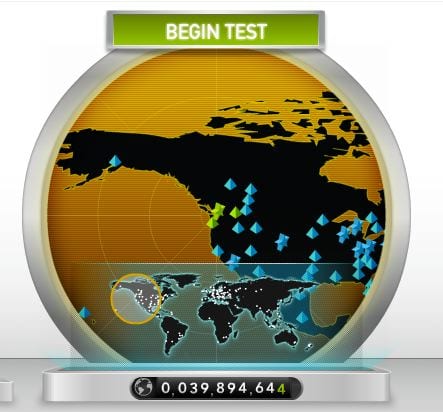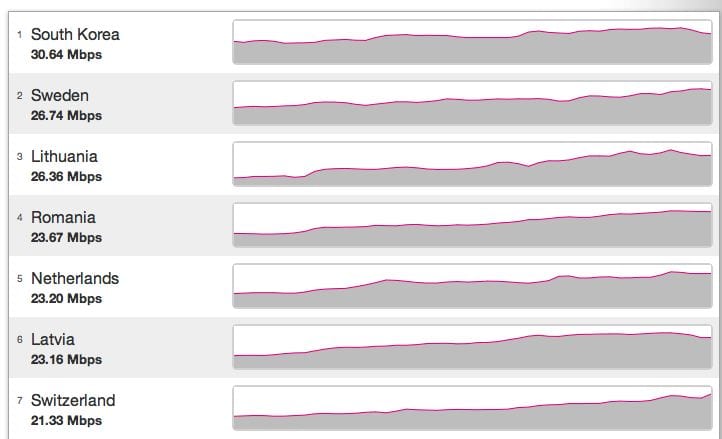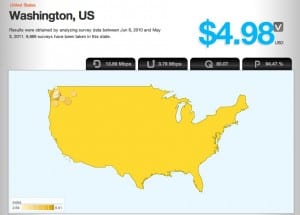Excuse me, but do you know how fast you were going? Yes, we’re talking to you, Mr. Ultra DSL, and you, Ms. Broadband. Okay, you too, young Wi-Max. Do you know the Internet speed (and quality) powering your online connectivity when it comes to surfing the Web, downloading messages and media files to your desktop, synching data with “the Cloud,” watching a movie via YouTube, Netflix or iTunes, or sharing your router with others over Ethernet or wireless? How does your Net plumbing compare with your neighbors next door or your friends and family across the country? How much bandwidth is being promised you by your ISP and are you getting your fair share? And just what are the standards for broadband cable, DSL, untethered WiMax andr mobile 3G, 4G or LTE — at what price?
One Seattle company answers each of these questions one to two million times every day via one of three Internet Web sites that, like virtual weather stations — monitor the Net’s “atmospheric” speed and convergence zones 24/7/365. The company’s name? It’s Ookla, named after a Persian cat owned by the founding CTO Doug Suttles. With Ookla, this feline has quickly become the king of the broadband beasts. After all, in today’s online world, how you leverage your Internet access can pay major productivity dividends and save you bandwidth maga-bucks. That’s the law of the jungle.
How did the Northwest manage to score the Internet’s land and air speed records like the great salt flats of Utah, the straightaways at the Indy 500 or the Mach One fly zone of the California desert? The answer is “easy.” When Seattle’s Speakeasy became one of the most popular DSL providers in the United States, it earned a reputation as the first place for businesses to turn for unbridled, B2B net connectivity. It was unselfish about provisioning bandwidth for the right price and not afraid to show it with Net speed data visualization software. When Speakeasy was purchased by Best Buy in 2007 (it has since merged into Covad and MegaPath ), one of the few assets that the original founders retained was the technology it used to measure and display connection speed for its customers. This was the progenitor of what would become Speedtest.net.
 In this exclusive Seattle24x7 interview, we open up the throttle to help you read your own digital dashboard via Speedtest.net, Pingtest.net and the Household Download Index at NetIndex.com, even how to stack up your best speeds against others in an online game called Speed Wave.
In this exclusive Seattle24x7 interview, we open up the throttle to help you read your own digital dashboard via Speedtest.net, Pingtest.net and the Household Download Index at NetIndex.com, even how to stack up your best speeds against others in an online game called Speed Wave.
CTO Suttles began his tech career on the hardware side of the industry but soon assumed the journeyman status of a Database Architect focused on Oracle and serving several Northwest concerns. These days, Doug can be spotted in and around Kirkland sporting one of the many mobile handsets he is constantly testing, or channel surfing the Web on either his Comcast or Clear connections.
Seattle24x7: What is the truest measure of Internet speed?
Suttles: From my point of view, there are really three parameters that measure the rate at which things take place on the Internet. The first is “throughput” or how much content can I move at one time. The second is “latency,” or how quickly can a packet get from here to there. And the third is what we call “packet loss.” If you send a packet and it it gets dropped en route, that will cause slowdowns. Those are the three gauges so to speak, and the last two, “latency” and “packet loss” are what we consider to be the “quality components.” Compared to the raw speed or volume of data being conveyed, they determine the accuracy and efficiency of delivery.
Seattle24x7: So it’s not just a question of how fast the data is being transacted but how efficiently?
Suttles: If I can make an analogy, picture a big dump truck that can transport, say, 100 Mb of data vs. a race car that carries, say 5 megabits. The latency is how fast each vehicle can get there and get back. Now, if the race cars holds, say, half as much as the dump truck, which probably is not the case, and if it could drive twice as fast, the end result would be the same. But the delivery route is also based on the distance between you and a server. It’s not a direct line. It’s routing from city to city through whatever Internet exchanges have decided to route you. If anything drops along the way, falls off the truck or falls out of the car, it has to be recovered.
 Besides Speedtest.net, we created Pingtest.net to measure the quality of a connection.
Besides Speedtest.net, we created Pingtest.net to measure the quality of a connection.
Seattle24x7: The Internet “protocol” is designed to prevent lost packets at all costs. So there’s no forgiving lost data for speed?
Suttles: There are 2 basic protocols using the Internet. There’s TCP, and then there’s UDP. TCP (or “Transmission Control Protocol”) is totally error correcting. You send something, and if it gets lost, it’ll try, try again. It will not give up until it can send and receive, or time out in some fashion. UDP (or “User Datagram Protocol”) is the other standard which is used quite often in games because it is “fire and forget.”
Seattle24x7: How do we as consumers measure the speed of the connection that an ISP is delivering to our homes?
Suttles: It’s often regarded as The Last Mile Connection. It’s called that because it’s measuring the space between you and the Internet. Once you get beyond that, you start measuring the Internet itself, which your ISP has no control over. What we have done at SpeedTest.net is to have a server close to you wherever in the world you are located. Currently, we have about 800 active hosts conducting tests to tell you your download and upload speeds, among other things.
Seattle24x7: How is the Last Mile test conducted?
Suttles: We are pretty much measuring what your last mile connection is. To make sure it is accurate, we don’t just do one transfer. We send parallel streams of data to try and fill that pipe. In other words, to use another analogy, we don’t just turn on one faucet in your home, and look at the flow. We want to see what happens if you turn on all your faucets until things start slowing down, then you’re getting your full throughput. We see that as the proper thing to measure.
Seattle24x7: That represents what the ISP is offering for a price?
Suttles: Right. The ISP is telling you that you should get this speed, so that’s what we measure, and we feel that it should be the most accountable number. We have a site that we’ve built just to expose all this data publicly. It’s called Netindex.com.
Seattle24x7: Based on your NetIndex testing, where does the United States rank on the world’s Netspeed Leader board?
Suttles: Based on a thirty day rolling average, out of all the countries in the world, the U.S. currently ranks 29th with an average download speed of 10.9 megabits per second. This would be the measure for home connectivity, but it pretty much reflects all broadband.
Seattle24x7: How do you explain that ranking? Why is the U.S. lower than other nations?
Suttles: There are many factors but the principal one is geography. It boils down to size. If an entire country is the size of one large American city and the government invests in that infrastructure, putting fiber everywhere, well it’s a different comparison. For instance, right now, South Korea is the fastest broadband country in the world by far. Their government has been willing to spend a lot of money, and their coverage area is small. A lot of the fastest countries are also the smallest countries. So as you look down the list of South Korea, Sweden, Romania, Switzerland, Germany. These are all, relatively speaking, much smaller countries compared to the U.S.
 Seattle24x7: How are you able to gather international SpeedTest results?
Seattle24x7: How are you able to gather international SpeedTest results?
Suttles: We collect Speedtest.net data from all over the world, transacting between 1-1/2 and 2 million tests everyday. For every test we know where that user is and we aggregate all that data together.
Seattle24x7: The Android and iOS mobile platforms are stealing a lot of headlines these days. You are also measuring their speeds. What can you tell us?
Suttles: We have native applications on both iOS and Android. One of the fascinating things that we see in our Android and iPhone data is that two out of three speed tests that come in on IPhone, are on Wi-fi. Only one out of three tests on Android is on Wi-fi. A reason for this is that the iPhone makes it very easy to hop onto a Wi-fi network. If it sees a Wi-fi network, it will say, hey, do you want to join this network? Or if you have been on the network before it can even join it automatically . Most Android implementations I’ve seen do not have that capability. On Android, WiFi is often not even on by default. So you have to go in manually, find the network, and join it if you’ve never been on it in the past. I think that simple difference between the two makes people not use WiFi nearly as much on their Android devices.
Seattle24x7: You’ve also adjudicated the speed trials between iPhones on Verizon and AT&T?
Suttles: The results came from 43,000 AT&T iPhones and 14,000 Verizon iPhones all over the United States. Most Speedtest.net app users ran the tests multiple times, totaling 106,000 results from AT&T iPhone users and 49,000 results from Verizon iPhone users.
On average, the reported AT&T iPhone transfer rates were roughly two times faster than the Verizon iPhone’s.The AT&T iPhone’s average download speed was 1,769 Kbps, and the average upload speed was 730 Kbps. By way of comparison, the Verizon iPhone’s average download speed was 848 Kbps, and the average upload speed was 506 Kbps.
Verizon has never talked up their speed, but they always talk up coverage and reliability. I think the story is quality versus throughput: What are you after?
Seattle24x7: You also track the price of broadband, both in other countries and between system operators in American markets. Can consumers use your service to shop for the best rates?
Suttles: Absolutely. Depending on where they live, rates will vary widely between urban and rural states and centers. For example, at the present day and date, the state of Alaska is at $14.68 per megabit. Montana is another rural area without a lot of high-tech infrastructure where the price per megabit is going to be highest,
Seattle24x7: Comparatively, if you live in Kirkland, Wash and are using Comcast services for a 105 Megabit download, you are paying around $105 dollars a month, or about one dollar per megabit?
Suttles I live in Kirkland and that’s what it means in my case. So I’m getting more megabits for my dollar but you know, I’m paying more to have that availability. There are a lot of people who pay, say, $50 bucks a month for a 10 megabit download so they’re at $5 per megabit.
 Seattle24x7: The Household Download Index at NetIndex.com, shows you who is offering service in your area, and for what price?
Seattle24x7: The Household Download Index at NetIndex.com, shows you who is offering service in your area, and for what price?
Suttles: Correct. Here in Kirkland, for example, it shows me the four ISPs are available here.Those being Comcast, Frontier, Verizon and Clearwire. I can see the average Clearwire speed in Kirkland is 3.1 megabits per second. And, in the case of WiMax, the peak standard is typically five. You can look at the perfomance graph over time and see that it’s pretty consistent.
Seattle24x7: This data would appear to counter the assertions reported in the media recently about Clearwire throttling their service.
Suttles: The data is going to vary based on the area and the latency and congestion can be a major factor.
Seattle24x7: What is the fastest connection speed you are clocking in Seattle?
Suttles: On average, it is actually a residential provider named Condo Internet (http://www.condointernet.net).
Seattle24x7: The Ookla NetIndex, breaks out an Upload Index, a Quality Index a Value Index and a Promise Index.
Stuttles: If you go the Value Index, you’ll see that $9.27 is the average cost per megabit, around the world. By comparison, here in Washington, the cost is $4.95 per Megabit. The Download Index shows our average download rate is 13.59 Mbps. The Household Quality Index for Seattle is 83.31based on 291,521 unique Seattle IPs and 1,881,597 total tests. And the Promise Index for Seattle is at 87.93% (it is 94.71% for all of Washington). The Promise Index will you how the speed you receive from our test compares to what you are being promised by your ISP. The good news is that ISPs are more than keeping their word, and even exceeding their promise in the major market areas. The biggest challenge right now is for rural areas that don’t have broadband. Those are what the government should focus on.
Seattle24x7: What is the biggest issue you run into with consumers not getting the bandwidth that is featured in your ISP Promise Index?
Suttles: Many times it is hardware related. Very often, consumers will plug in an old router that may top out at 10 Mbps and that will prevent them from getting speeds that are any higher. I’ll suggest they plug their laptop directly into the cable modem and see how fast it is. “Hey, now it’s 30 Mbps!” An old router can be a bottleneck or another network device.
Seattle24x7: Is it true that if you are using a cordless phone that is 80211 ‘a’ or ‘b’ (compared to the latest ‘n” draft standard) that it will slow down the network to the slower speed?
Suttles: It is. That is why you may need a dual channel router to keep an open channel for your high speed traffic and to make sure you have chosen the right channel in your Wi-Fi base station instead of letting it “auto pick” one for you. If you feel like you’re getting interference or speed degradation at times of the day when certain devices are on, just try another channel. It can help!
Seattle24x7: Ookla has created a competitive, gane-like method to compare connection speeds?
Suttles: Yes, it’s called Speed Wave. Think of it as a Leader Board. It will measure your speed and post it to the board according to where you rank next to others in the test. The current leader on page one has a live gigabit connection to the internet. He’s actually at Dreamhost, one of our sponsors, on a server in L.A.
Anyone can make a Speed Wave. Once you create one of the waves you can then share the URL with your friends and they could do a comparison test. You can also compare Speed Waves in a test limited only to your friends or to your community.
For instance a community newsletter could invite everyone to take the test in order to measure the broadband in their town. The Speed Wave gives them a way to do it as a group ay zero cost to them.
Seattle24x7: Thanks for a very speedy download, Doug. And good luck capturing those Speed waves! [24×7]





















